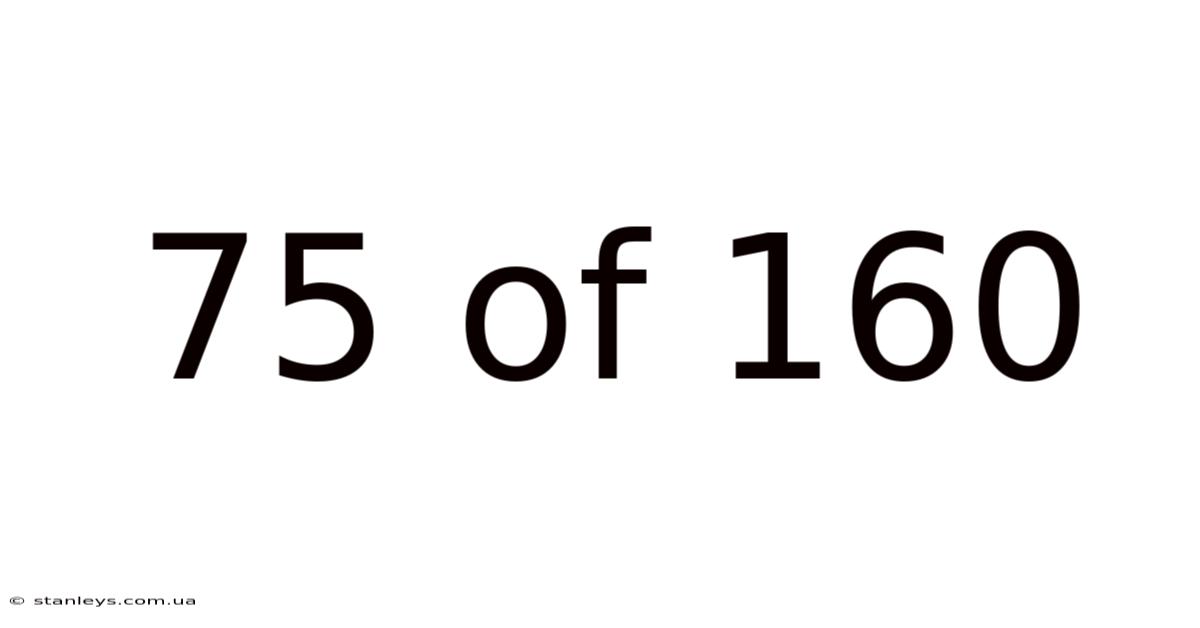75 Of 160
stanleys
Sep 17, 2025 · 4 min read

Table of Contents
Understanding the Fraction 75/160: A Deep Dive into Simplification, Decimals, and Percentages
The fraction 75/160 might seem intimidating at first glance, but understanding its intricacies reveals a wealth of mathematical concepts. This article will guide you through simplifying this fraction, converting it to a decimal and percentage, and exploring its applications in various contexts. We'll break down the process step-by-step, making it accessible for learners of all levels. By the end, you'll not only understand 75/160 but also gain a stronger grasp of fundamental mathematical principles.
Introduction: Deconstructing the Fraction 75/160
The fraction 75/160 represents a part of a whole. The number 75 is the numerator, indicating the number of parts we have, while 160 is the denominator, representing the total number of equal parts in the whole. Our goal is to understand this fraction more deeply, learning how to simplify it, represent it as a decimal and percentage, and ultimately, how to use it in real-world scenarios.
Step-by-Step Simplification of 75/160
Simplifying a fraction means reducing it to its lowest terms. This is done by finding the greatest common divisor (GCD) of the numerator and denominator and dividing both by it. Let's find the GCD of 75 and 160.
One method is to list the factors of each number:
- Factors of 75: 1, 3, 5, 15, 25, 75
- Factors of 160: 1, 2, 4, 5, 8, 10, 16, 20, 32, 40, 80, 160
The greatest common factor shared by both 75 and 160 is 5.
Therefore, we divide both the numerator and denominator by 5:
75 ÷ 5 = 15 160 ÷ 5 = 32
This simplifies the fraction 75/160 to 15/32. This is the simplest form because 15 and 32 share no common factors other than 1.
Converting 15/32 to a Decimal
Converting a fraction to a decimal involves dividing the numerator by the denominator. In this case, we divide 15 by 32:
15 ÷ 32 = 0.46875
Therefore, the decimal equivalent of 15/32 (and thus 75/160) is 0.46875.
Converting 15/32 to a Percentage
To convert a decimal to a percentage, we multiply the decimal by 100 and add the percentage sign (%).
0.46875 x 100 = 46.875
Therefore, the percentage equivalent of 15/32 (and thus 75/160) is 46.875%.
Real-World Applications of 75/160 and its Simplified Form
The fraction 75/160, and its simplified form 15/32, can be applied in various real-world situations. Consider these examples:
-
Proportions: If you have a bag of 160 marbles, and 75 of them are red, the fraction 75/160 (or 15/32) represents the proportion of red marbles in the bag.
-
Measurements: Imagine a project requiring a piece of wood 160 centimeters long. If you need to cut off a section 75 centimeters long, the fraction represents the proportion of the total length that has been cut.
-
Statistics: In a survey of 160 people, if 75 responded positively to a particular question, the fraction indicates the percentage of positive responses.
-
Probability: If there are 160 equally likely outcomes in an event, and 75 of them result in a specific result, the fraction represents the probability of that specific result occurring.
Further Mathematical Exploration: Prime Factorization
Understanding prime factorization can further illuminate the simplification process. Prime factorization breaks down a number into its prime factors (numbers only divisible by 1 and themselves).
- Prime factorization of 75: 3 x 5 x 5 = 3 x 5²
- Prime factorization of 160: 2 x 2 x 2 x 2 x 2 x 5 = 2⁵ x 5
By comparing the prime factorizations, we can clearly see the common factor of 5, which we used to simplify the fraction. This method is particularly useful when dealing with larger numbers.
Frequently Asked Questions (FAQ)
Q1: Is there a quicker way to find the GCD of 75 and 160?
A1: Yes, the Euclidean algorithm provides a more efficient method for finding the GCD of two numbers. This algorithm involves repeatedly applying the division algorithm until the remainder is 0. The last non-zero remainder is the GCD.
Q2: Can I convert 75/160 directly to a percentage without simplifying?
A2: Yes, you can. You would divide 75 by 160 and then multiply the result by 100%. The result will be the same (46.875%). However, simplifying the fraction often makes the calculations easier and the result clearer.
Q3: What if the denominator is zero?
A3: A fraction with a denominator of zero is undefined. Division by zero is not possible in mathematics.
Conclusion: Mastering Fractions – A Foundation for Further Learning
Understanding fractions like 75/160 is crucial for developing strong mathematical foundations. Through simplification, conversion to decimals and percentages, and exploring real-world applications, we've seen how a seemingly complex fraction can be broken down into manageable components. This understanding extends far beyond simple calculations, forming a bedrock for more advanced mathematical concepts in algebra, calculus, and beyond. Remember, the key is to approach these problems systematically, breaking them down into smaller, more manageable steps. The more you practice, the more confident and proficient you'll become in working with fractions and other mathematical concepts. The ability to confidently manipulate fractions is a vital skill for success in many academic and professional fields.
Latest Posts
Latest Posts
-
68inches In Cm
Sep 17, 2025
-
Slide Board Transfer
Sep 17, 2025
-
Demand Characteristics Psychology
Sep 17, 2025
-
10 Of 9000
Sep 17, 2025
-
16 Square Feet
Sep 17, 2025
Related Post
Thank you for visiting our website which covers about 75 Of 160 . We hope the information provided has been useful to you. Feel free to contact us if you have any questions or need further assistance. See you next time and don't miss to bookmark.